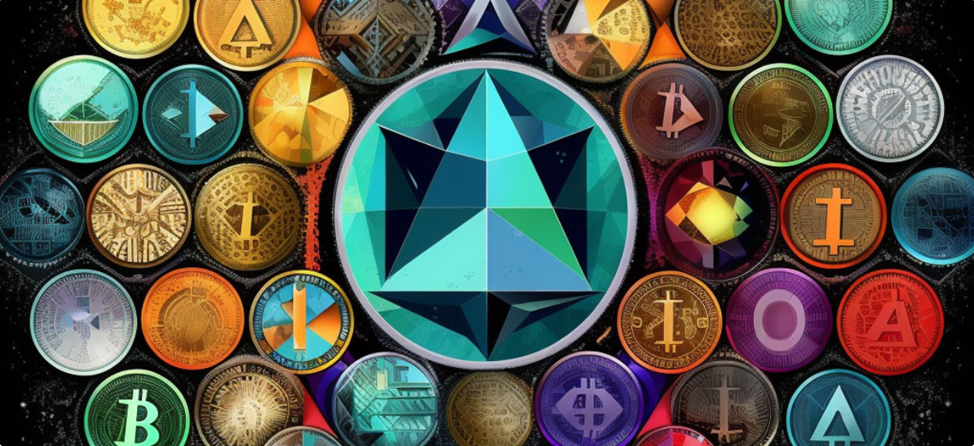
Bitcoin has long reigned supreme as the unchallenged leader in the dynamic world of cryptocurrencies. The crypto environment, however, is far from a one-trick pony. A plethora of other digital currencies, known colloquially as altcoins, have developed to threaten Bitcoin’s dominance and revamp the financial landscape.
Although the term sounds similar to Bitcoin, altcoins have nothing to do with Bitcoin. These digital tokens have proliferated, each with its own set of characteristics, capabilities, applications, and possible investment opportunities. This blog post will unravel the term “altcoin” and explain what it is. It’ll also discuss the benefits and risks of altcoins and various types of altcoins, provide some investment suggestions and techniques, and what makes them different from the granddaddy of them all, Bitcoin.
What are Altcoins?
The term “altcoin” is derived from the phrases “alternative” and “coin.” The word broadly refers to all cryptocurrencies and tokens other than Bitcoin. Altcoins evolved as alternatives to Bitcoin, attempting to overcome some of the perceived flaws of the pioneer cryptocurrency. They are digital assets that work in the same way as Bitcoin but are developed on separate blockchain systems with different features and functionalities. They function independently of a central bank and rely on cryptography for security. Since the introduction of the first altcoin, Litecoin, in 2011, dozens of other altcoins have been established, each trying to give distinct value propositions to the cryptocurrency industry.
Altcoins are typically generated through a process known as “forking,” in which developers modify the current codebase of a certain cryptocurrency (usually Bitcoin) to create a new coin with distinct properties. This can be done to improve existing technology or merely for the sake of exploration.
Altcoins vs. Bitcoin
Altcoins are distinguished from Bitcoin in various ways:
- Age: Bitcoin debuted in 2009, whereas the first altcoins debuted in 2011. New altcoins are constantly being released.
- Risk vs. Reward: While Bitcoin is volatile, it’s still the market leader and has already risen significantly in value. Altcoins have more possibility for growth, but they also have concerns.
- Technological Advancements: Altcoins are often constructed on superior technology than Bitcoin, allowing for faster transaction speeds and cheaper transaction fees.
- Market Value: Bitcoin has emerged as the most valuable cryptocurrency, having a market capitalization of over 600 billion dollars as of April 2021. In comparison, the total market capitalization of all altcoins combined is approximately 1 trillion dollars. This substantial gap in market cap indicates Bitcoin’s dominance in the crypto market, yet it also highlights the potential for diversification and development within the altcoin space.
The Evolution of Altcoins
The history and evolution of altcoins are intriguing because they deliver light on the creation and growth of the cryptocurrency market. Altcoins, or alternative cryptocurrencies, are any digital currencies that are not Bitcoin, the largest cryptocurrency that began it all in 2009. While Bitcoin remains the industry’s biggest player, altcoins have gained enormous popularity over the years and now account for a considerable segment of the overall cryptocurrency market.
The Birth of Litecoin
Charlie Lee introduced Litecoin in 2011, barely two years after Satoshi Nakamoto established Bitcoin. It is sometimes described as “the silver to Bitcoin’s gold.” Litecoin was created on the same principles as Bitcoin but unlike Bitcoin, it is quicker and more effective with transaction processing. It soon gained traction with early adopters and went on to become one of the first successful altcoins.
The Period of Forks
As cryptocurrencies grew in popularity, developers began building new ones based on current blockchain technology. These new coins were called “forks” since they were produced by cloning a prior coin’s codebase and making changes to it. One famous example is Dogecoin, which was developed in 2013 as a fork of Luckycoin (that was itself a fork of Litecoin). Initially conceived as joke money based on a well-known internet meme, Dogecoin developed surprising appeal due to its robust community and less barrier-to-entry for mining.
Types Altcoins
Altcoins are available in several forms, each designed to meet specific requirements or to push the boundaries of blockchain networks. Here are some examples of common altcoins:
Bitcoin Forks
These altcoins are produced by branching out from the Bitcoin blockchain. Bitcoin SV (BSV) and Bitcoin Cash (BCH) are two such examples. They frequently seek to cope with scalability or other difficulties.
Stablecoins
Stablecoins are cryptocurrencies designed to provide stability in value by linking their price to the value of a fiat currency. These currencies serve as a bridge between the crypto world and traditional finance. Tether (USDT) and USD Coin (USDC) are some of the notable stablecoins.
Utility Tokens
Many altcoins serve as utility tokens within specialized ecosystems. Binance Coin (BNB), for example, is utilized to pay transaction fees on the Binance exchange, while Chainlink (LINK) enables smart contracts by linking them to real-world data.
Governance Tokens
Governance tokens grant holders to vote on the prospects of a project or blockchain network. These tokens enable users to create and vote on cryptocurrency-related proposals, which contributes to the cryptocurrency’s decentralized character and ensures that decisions are not determined by a single central authority.
Privacy Coins
Privacy-focused altcoins like Zcash (ZEC) and Monero (XMR) prioritize the confidentiality and anonymity of transactions through powerful cryptographic methods. They are suitable for users who prefer privacy in financial activities and make transactions more private than those on public blockchains.
Meme Coins
Meme coins are typically popular due to their wit or cultural relevance instead of technological advancement. Dogecoin (DOGE) is a classic example, which started as a meme before transforming into a cryptocurrency.
Non-Fungible Tokens (NFTs)
NFTs demonstrate ownership of distinctive digital possessions such as digital art or collectibles on blockchain. Ethereum-based currencies such as Decentraland (MANA) and CryptoKitties (CAT) have garnered traction in this market.
Factors Affecting Altcoin Values
- Market Sentiment: Market sentiment has a significant impact on altcoin prices. Positive news, alliances, and developments frequently result in price increases, while unfavorable occurrences might result in substantial price decreases.
- Technology and Innovation: The fundamental technology and novel characteristics of altcoins add to their value proposition. Projects that bring unique ideas, improve scalability, or boost security may attract investor interest.
- Regulatory Environment: Altcoins are vulnerable to regulatory developments that can affect their acceptance and value. Precise and beneficial rules frequently lead to a favorable market environment.
- Community and Development: Active community interaction and continuing development are signs of a flourishing altcoin project. A passionate community can fuel adoption, while continual development guarantees the altcoin stays relevant and competitive.
The Possible Effect of Altcoins and Why You Should Consider Investing in Them?
There are various reasons why investors could opt for investing in an altcoin. Some of them are:
Competition and Innovation
Altcoins threaten Bitcoin’s dominance, fostering innovation and advancement in the cryptocurrency sector. This competition may result in more scalable, efficient, and user-friendly blockchain technology. For example, Bitcoin’s prominence has prompted developers to investigate solutions to its scalability concerns, causing the creation of layer-2 solutions such as the Lightning Network.
Similarly, altcoins frequently experiment with consensus mechanisms, governance structures, and transaction speeds, forcing the entire cryptocurrency ecosystem to grow and adapt to match the demands of consumers and companies.
Use Cases Other Than Currency
An altcoin frequently brings fresh applications for blockchain technology. Smart contracts on Ethereum, for example, have opened up a new universe of opportunities for decentralized applications. These smart contracts permit self-executing agreements by directly writing the contract terms into code.
This breakthrough has given rise to a slew of decentralized applications like decentralized finance (DeFi) platforms that offer lending, borrowing, and trading without the use of intermediaries. As mentioned earlier, altcoins have fueled the growth of non-fungible tokens (NFTs), which are one-of-a-kind digital assets with uses in art, gaming, collectibles, and beyond. The growth of altcoins continues to broaden the possibilities of blockchain technology, with every fresh endeavor providing its own set of features and applications.
Financial Inclusion
Altcoins may provide financial services to underrepresented groups by making transactions, savings, and investments more accessible and affordable. Cryptocurrency investment can be beneficial in areas where traditional financial services are scarce. Individuals can acquire access to a global financial system that doesn’t rely on traditional intermediaries by using altcoins.
This creates possibilities for peer-to-peer lending, microfinance, and cross-border remittances among other financial services. Furthermore, altcoins can provide stability in countries with unpredictable native currencies since people may stash their wealth in cryptocurrencies, offering a form of security against inflation and economic upheaval.
In short, investors can choose to invest in altcoins for the following reasons:
- They have the possibility of higher returns. They can often see huge price gains, especially if they are capable of solving a specific need or achieving widespread support.
- They can also be used to diversify a cryptocurrency portfolio. Bitcoin is not the only cryptocurrency. Investors can diversify their risk over numerous projects and potentially decrease the impact of any one project failing by investing in a range of cryptocurrencies.
- Active traders can benefit from investing in altcoins. Altcoins can be extremely volatile, providing possibilities for traders to buy and sell at the perfect time to profit.
Altcoin-Investing Strategies
There are various straightforward techniques for investing in altcoins. One of them is to go all in and HODL when you find a coin/token you like. This effectively means that you would invest your money, secure the earnings in Bitcoin wallets, and keep them. Whatever happens, you keep them, hoping that their price will (maybe) rise someday. This is not the best method for altcoins, but many believe it is ideal for Bitcoin.
A safer way is to diversify your portfolio by trading in multiple assets. In this case, you’d concentrate on an altcoin with the most potential, whether that’s due to their technology, aims, popularity, or some other factor. Identify and invest in various assets that you believe have a future.
Another strategy to think about is actively trading cryptocurrencies. You store your asset and forget about it when it comes to investing. Investments are supposedly long-term but crypto trading is not. Some traders buy assets just to sell them a couple of days later. Others may have them for a few weeks, whereas some just keep them for a few hours. The plan is to buy them and then sell them at an appropriate opportunity. Hopefully, the price differential will allow you to profit.
Risks and Considerations
While altcoins are quite enticing, providing possible chances for investors, it is essential to be aware of related risks. One of the most significant hazards is that many altcoins have low user adoption. This means that their value is determined primarily by speculation and excitement instead of any underlying fundamentals.
Another concern is that altcoins may be prone to market manipulation. Because many altcoins have a lower market cap than Bitcoin, they can be influenced more readily by massive investors or “whales” who own significant amounts of the coin.
Finally, the altcoin market can be vulnerable to security threats like hacking or fraud. Because most altcoins are still new and untested, their security measures may be weaker than those of more established cryptocurrencies such as Bitcoin. The best thing that can be done before buying altcoins is to research thoroughly and try to acquire facts before making any moves. Moreover, diversifying your portfolio is also a good idea, but be cautious.
Conclusion
Altcoins are key components of the cryptocurrency ecosystem, offering a variety of solutions and opportunities to investors. Altcoins are more than just alternatives; they are a testament to the cryptocurrency revolution’s ingenuity and limitless possibilities. Investing in altcoins, however, is not without risk, and users should conduct their research, stay informed, and be mindful of potential dangers before investing in any cryptocurrency.





